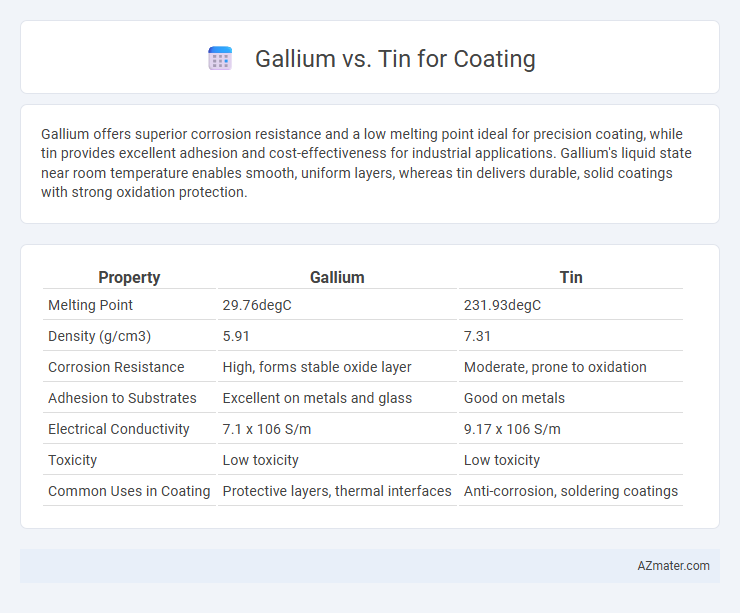Gallium offers superior corrosion resistance and a low melting point ideal for precision coating, while tin provides excellent adhesion and cost-effectiveness for industrial applications. Gallium's liquid state near room temperature enables smooth, uniform layers, whereas tin delivers durable, solid coatings with strong oxidation protection.
Table of Comparison
| Property | Gallium | Tin |
|---|---|---|
| Melting Point | 29.76degC | 231.93degC |
| Density (g/cm3) | 5.91 | 7.31 |
| Corrosion Resistance | High, forms stable oxide layer | Moderate, prone to oxidation |
| Adhesion to Substrates | Excellent on metals and glass | Good on metals |
| Electrical Conductivity | 7.1 x 106 S/m | 9.17 x 106 S/m |
| Toxicity | Low toxicity | Low toxicity |
| Common Uses in Coating | Protective layers, thermal interfaces | Anti-corrosion, soldering coatings |
Understanding Gallium and Tin: An Overview
Gallium and tin are both metals used for coating applications, with distinct properties influencing their effectiveness. Gallium features a low melting point of about 29.76degC, enabling it to remain liquid near room temperature, making it ideal for thermal interface materials and flexible coatings. Tin, with a higher melting point of 231.93degC, offers excellent corrosion resistance and is widely used in soldering and protective coatings to prevent oxidation on steel and other metals.
Physical and Chemical Properties Comparison
Gallium and tin exhibit distinct physical and chemical properties that influence their suitability for coating applications. Gallium has a low melting point of 29.76degC, allowing it to remain liquid near room temperature, while tin's melting point is much higher at 231.93degC, providing greater thermal stability in coatings. Chemically, gallium is more reactive, forming stable oxides and exhibiting amphoteric behavior, whereas tin is less reactive and primarily forms stable tin oxides, resulting in enhanced corrosion resistance for protective coatings.
Coating Process: Gallium vs Tin Techniques
Gallium coating involves a low-temperature process leveraging liquid metal alloys that enable uniform adhesion to substrates by wetting a wide range of materials, often used in flexible electronics and sensors. Tin coating, typically applied through electroplating or hot-dip methods, creates a robust, corrosion-resistant layer, favored in traditional soldering and tinplate manufacturing. Gallium's unique ability to alloy at near-room temperature contrasts with tin's higher thermal processing requirements, offering distinct advantages based on application demands and substrate sensitivity.
Adhesion and Surface Compatibility
Gallium exhibits superior adhesion properties on a variety of metal surfaces due to its ability to form stable intermetallic compounds, enhancing coating durability and conductivity. Tin, while widely used for its non-toxicity and corrosion resistance, demonstrates moderate adhesion, often requiring surface treatment to improve bonding on substrates like copper or steel. Surface compatibility favors gallium for applications needing strong metallic bonding, whereas tin suits environments prioritizing corrosion protection and solderability.
Corrosion Resistance and Durability
Gallium offers superior corrosion resistance compared to tin, especially in environments with high moisture or acidic exposure, due to its stable oxide layer that prevents further degradation. Tin, while traditionally favored for its solderability and mild corrosion resistance, tends to weaken faster under harsh conditions, leading to reduced durability. Coatings using gallium typically provide longer-lasting protection on metal surfaces, making them ideal for applications requiring enhanced longevity and resistance to corrosive elements.
Electrical and Thermal Conductivity
Gallium exhibits superior electrical conductivity compared to tin, making it ideal for applications requiring efficient electron flow in coatings. Tin offers moderate thermal conductivity, but gallium outperforms it substantially, enabling better heat dissipation in electronic components. The choice between gallium and tin coatings depends on balancing conductivity needs with factors like melting point and material compatibility.
Cost Analysis: Gallium vs Tin
Gallium's higher cost compared to tin significantly impacts its viability for coating applications, with gallium priced around $300 per kilogram versus tin's average of $25 per kilogram. The expense of gallium stems from its limited availability and complex extraction processes, while tin benefits from widespread mining and established supply chains. For large-scale industrial coatings, tin offers a more economical solution without compromising corrosion resistance and surface properties.
Environmental and Safety Considerations
Gallium exhibits low toxicity and is considered environmentally safer compared to tin, which can pose risks due to its potential to release harmful organotin compounds. Gallium's non-reactive nature reduces environmental contamination, while tin mining and processing often involve more hazardous chemical use and waste. Using gallium coatings can minimize ecological hazards and improve workplace safety during application and disposal.
Industrial Applications and Use Cases
Gallium offers superior corrosion resistance and low toxicity compared to tin, making it ideal for coatings in electronics and aerospace industries where durability and environmental safety are critical. Tin, with its excellent solderability and cost-effectiveness, remains the standard choice for coatings in food packaging, electrical components, and automotive parts. Industrial applications leverage gallium's melting point near room temperature for liquid metal coatings, while tin's ease of electroplating suits large-scale protective layers in manufacturing.
Future Trends in Metal Coating Technology
Gallium and tin are increasingly favored in metal coating for their unique anti-corrosive and conductive properties, with gallium's low melting point enabling innovative applications in flexible electronics and thermal management. Future trends highlight gallium's role in advanced nanocoatings and smart materials, while tin maintains dominance in traditional soldering and lead-free coatings due to its stability and affordability. Emerging research prioritizes hybrid coatings combining gallium's fluidity with tin's durability to enhance performance in aerospace and wearable technology sectors.

Infographic: Gallium vs Tin for Coating
 azmater.com
azmater.com